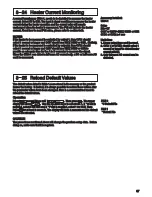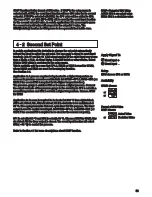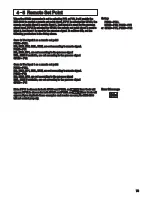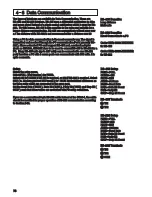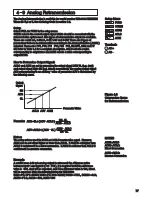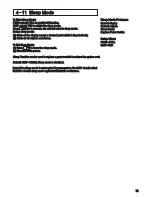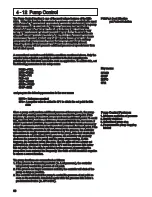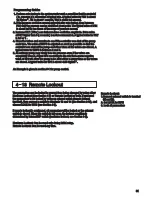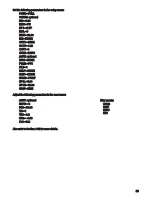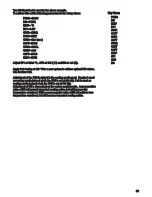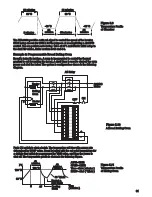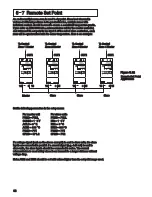
81
Programming Guide:
Programming Guide:
1. Perform auto-tuning to the system under such a condition that the material
( ie. pressure ) is exhausted at typical rate. A typical value for PB1 is about
10 Kg/cm , TI1 is about 1 second, TD1 is about 0.2 second.
2. If the process oscillates around set point after auto-tuning, then increase
PB1 until the process can be stabilized at set point. The typical value of PB1
is about half to two times of the range of pressure sensor.
1. Perform auto-tuning to the system under such a condition that the material
( ie. pressure ) is exhausted at typical rate. A typical value for PB1 is about
10 Kg/cm , TI1 is about 1 second, TD1 is about 0.2 second.
2. If the process oscillates around set point after auto-tuning, then increase
PB1 until the process can be stabilized at set point. The typical value of PB1
is about half to two times of the range of pressure sensor.
3. Increase FILT ( Filter ) can further reduce oscillation amplitude. But a value
of FILT higher than 5 ( seconds ) is not recommended. A typical value for FILT
is 0.5 or 1 .
4. Close the valves and examine to see if the controller can shut off the pump
each time. The value of REFC is adjusted as small as possible so that the
controller can shut off the pump each time when all the valves are closed. A
typical value for REFC is between 3 and 5.
5. An ordinary pump may slowly lose the pressure even if the valves are
completely closed. Adjust SP2 according to the rule that a more negative
value of SP2 will allow the pump to be shut off for a longer time as the valves
are closed. A typical value for SP2 is about -0.50 Kg/cm .
3. Increase FILT ( Filter ) can further reduce oscillation amplitude. But a value
of FILT higher than 5 ( seconds ) is not recommended. A typical value for FILT
is 0.5 or 1 .
4. Close the valves and examine to see if the controller can shut off the pump
each time. The value of REFC is adjusted as small as possible so that the
controller can shut off the pump each time when all the valves are closed. A
typical value for REFC is between 3 and 5.
5. An ordinary pump may slowly lose the pressure even if the valves are
completely closed. Adjust SP2 according to the rule that a more negative
value of SP2 will allow the pump to be shut off for a longer time as the valves
are closed. A typical value for SP2 is about -0.50 Kg/cm .
An
is given in
for pump control.
Example
section 5-1
An
is given in
for pump control.
Example
section 5-1
2
2
4 13 Remote Lockout
4 13 Remote Lockout
The parameters can be locked to prevent from being changed by using either
(see
) or
or
. If you need
the parameters to be locked by using an external switch (remote lockout
function), then connect a switch to terminals 13 and 14 (see
), and
choose
for
(see
).
If remote lockout is configured, all parameters will be locked as the external
switch is closed. When the switch is left open, the lockout condition is
determined by internal DIP switch (hardware lockout, see
).
Hardware Lockout
Section 1-3
Remote Lockout
both
Section 2-10
LOCK
EIFN
Section 4-1
Section 1-3
The parameters can be locked to prevent from being changed by using either
(see
) or
or
. If you need
the parameters to be locked by using an external switch (remote lockout
function), then connect a switch to terminals 13 and 14 (see
), and
choose
for
(see
).
If remote lockout is configured, all parameters will be locked as the external
switch is closed. When the switch is left open, the lockout condition is
determined by internal DIP switch (hardware lockout, see
).
Hardware Lockout
Section 1-3
Remote Lockout
both
Section 2-10
LOCK
EIFN
Section 4-1
Section 1-3
Hardware Lockout:
Remote Lockout:
Can be used only during initial setup.
Can be used any time.
Hardware Lockout:
Remote Lockout:
Can be used only during initial setup.
Can be used any time.
Remote Lockout:
LOCK
EIFN
1.Connect external switch to terminal
and
.
2. Set
for
3. Lock all parameters
Remote Lockout:
LOCK
EIFN
1.Connect external switch to terminal
and
.
2. Set
for
3. Lock all parameters
17
16

